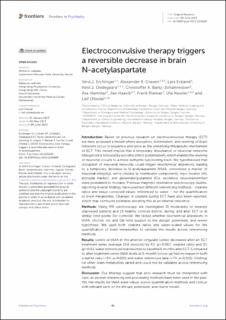| dc.description.abstract | Introduction: Based on previous research on electroconvulsive therapy (ECT) we have proposed a model where disruption, potentiation, and rewiring of brain networks occur in sequence and serve as the underlying therapeutic mechanism of ECT. This model implies that a temporary disturbance of neuronal networks (disruption) is followed by a trophic effect (potentiation), which enables the rewiring of neuronal circuits to a more euthymic functioning brain. We hypothesized that disruption of neuronal networks could trigger biochemical alterations leading to a temporary decrease in N-acetylaspartate (tNAA, considered a marker of neuronal integrity), while choline (a membrane component), myo-Inositol (mI, astroglia marker), and glutamate/glutamine (Glx, excitatory neurotransmitter) were postulated to increase. Previous magnetic resonance spectroscopy studies, reporting diverse findings, have used two different referencing methods - creatine ratios and tissue corrected values referenced to water – for the quantification of brain metabolites. Changes in creatine during ECT have also been reported, which may confound estimates adopting this as an internal reference.
Methods: Using MR spectroscopy, we investigated 31 moderately to severely depressed patients and 19 healthy controls before, during, and after ECT or at similar time points (for controls). We tested whether biochemical alterations in tNAA, choline, mI, and Glx lend support to the disrupt, potentiate, and rewire hypothesis. We used both creatine ratios and water-scaled values for the quantification of brain metabolites to validate the results across referencing methods.
Results: Levels of tNAA in the anterior cingulate cortex decreased after an ECT treatment series (average 10.6 sessions) by 6% (p = 0.007, creatine ratio) and 3% (p = 0.02, water referenced) but returned to baseline 6 months after ECT. Compared to after treatment series tNAA levels at 6-month follow-up had increased in both creatine ratio (+6%, p < 0.001) and water referenced data (+7%, p < 0.001). Findings for other brain metabolites varied and could not be validated across referencing methods.
Discussion: Our findings suggest that prior research must be interpreted with care, as several referencing and processing methods have been used in the past. Yet, the results for tNAA were robust across quantification methods and concur with relevant parts of the disrupt, potentiate, and rewire model. | en_US |

